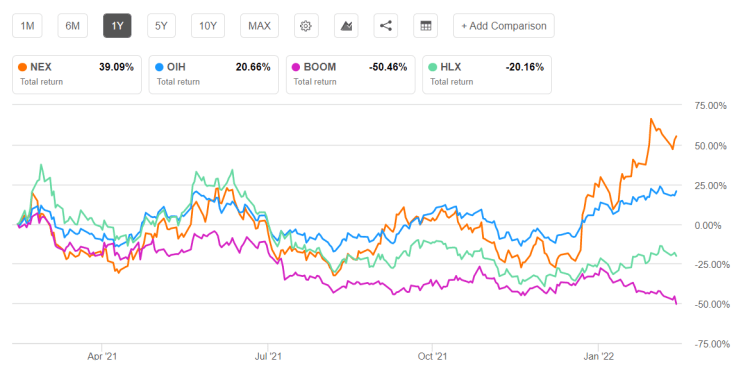- Revenue estimates are much higher in the next year and stable afterward
- EBITDA can increase sharply in NTM 2022 but will decelerate in the following year and decline after that
- The stock is reasonably valued at the current level
In Part 1 of this article, we discussed NexTier’s outlook, performance, and financial condition. In this part, we will discuss more.
Linear Regression Based Forecast

Based on a regression equation between the key industry indicators and NEX’s reported revenues, I expect revenues to increase sharply, particularly in the next 12-months (or NTM). The topline growth can moderate in the next 12 months (or NTM) 2024.

Based on the regression model using the average forecast revenues, I expect the company’s EBITDA to increase steeply in NTM 2022. While it will continue to grow at a more normalized rate in NTM 2023, EBITDA can fall in NTM 2024.
Target Price And Relative Valuation

EV has been calculated using the forward and past five-year average multiple. Returns potential (32% downside) using the forward EV/EBITDA multiple (7.4x) is lower than Wall Street’s sell-side analyst expectations (2.7% upside) and the past average (53% upside) from the stock.

NEX’s forward EV-to-EBITDA multiple contraction versus the adjusted trailing 12-month EV/EBITDA is steeper than its peers, which typically reflects a higher EV/EBITDA multiple than the peers. The stock’s EV/EBITDA multiple (37.3x) is lower than its peers’ (BOOM, HLX, and DRQ) average of 105x. So, valuation-wise, the stock is nearly balanced at the current level.
What’s The Take On NEX?

Natural gas-powered frac fleets will see high demand as the energy price shoots up and drilling activity rises. The natural gas-powered fleets will command a pricing premium over conventional diesel-powered frac equipment in an undersupplied market. Although NEX’s frac fleet will remain steady in the short term, the CAT Tier IV hydraulic fracturing fleets received through the Alamo acquisition will continue to benefit the company’s fleet mix, leading to a higher margin. The company’s frac plus fueling model will enable an integrated completion services model. With various tailwinds, the stock performed in line with the VanEck Vectors Oil Services ETF (OIH) in the past year.
However, the pricing level remains low, given the level of excess frac equipment in the market. It will encourage the management to keep the nameplate pumping capacity minimum. The inflationary costs in steel, chemicals, sand, trucking, and labor are likely to continue in the short term. NEX ended 2021 with negative cash flows and a leveraged balance sheet. The stock is reasonably valued relative to its peers at this level, encouraging investors to hold it for an upside in the medium to long term.













